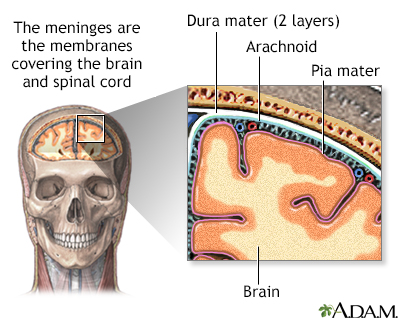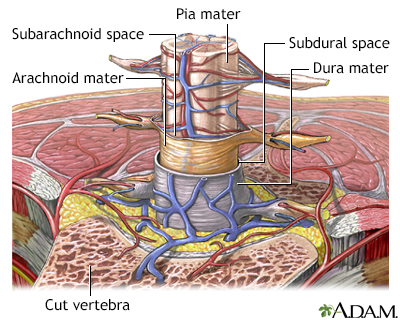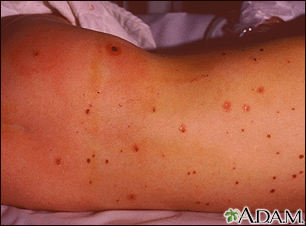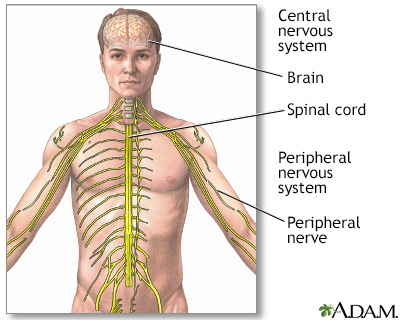Meningitis - meningococcal
Gram negative - meningococcus
Meningitis is an infection of the membranes covering the brain and spinal cord. This covering is called the meninges.
Bacteria are one type of germ that can cause meningitis. The meningococcal bacteria are one kind of bacteria that causes meningitis.

The organs of the central nervous system (brain and spinal cord) are covered by connective tissue layers collectively called the meninges. Consisting of the pia mater (closest to the CNS structures), the arachnoid and the dura mater (farthest from the CNS), the meninges also support blood vessels and contain cerebrospinal fluid. These are the structures involved in meningitis, an inflammation of the meninges, which, if severe, may become encephalitis, an inflammation of the brain.

The organs of the central nervous system (brain and spinal cord) are covered by 3 connective tissue layers collectively called the meninges. Consisting of the pia mater (closest to the CNS structures), the arachnoid and the dura mater (farthest from the CNS), the meninges also support blood vessels and contain cerebrospinal fluid. These are the structures involved in meningitis, an inflammation of the meninges, which, if severe, may become encephalitis, an inflammation of the brain.

Meningococcemia is a life-threatening infection that occurs when the bacteria Neisseria meningitidis invades the blood stream. Bleeding into the skin (petechiae and purpura) usually occurs and the tissue may die (become necrotic or gangrenous). If the patient survives, the areas heal with scarring.

The central nervous system comprises the brain and spinal cord. The peripheral nervous system includes all peripheral nerves.

CSF (cerebrospinal fluid) is a clear fluid that circulates in the space surrounding the spinal cord and brain. A CSF cell count is a test to measure the number of red and white blood cells that are in CSF.

One of the physically demonstrable symptoms of meningitis is Brudzinski's sign. Severe neck stiffness causes a patient's hips and knees to flex when the neck is flexed.

One of the physically demonstrable symptoms of meningitis is Kernig's sign. Severe stiffness of the hamstrings causes an inability to straighten the leg when the hip is flexed to 90 degrees.
Causes
Meningococcal meningitis is caused by the bacteria Neisseria meningitidis (also known as meningococcus).
Meningococcus is the most common cause of bacterial meningitis in children and teens. It is a leading cause of bacterial meningitis in adults.
The infection occurs more often in winter or spring. It may cause local epidemics at boarding schools, college dormitories, or military bases.
Risk factors include recent exposure to someone with meningococcal meningitis, complement deficiency, use of eculizumab, spleen removal or a spleen that does not function, and exposure to cigarette smoking.
Symptoms
Symptoms usually come on quickly, and may include:
- Fever and chills
- Mental status changes
- Nausea and vomiting
- Purple, bruise-like areas (purpura)
- Rash, pinpoint red spots (petechiae)
- Sensitivity to light (photophobia)
- Severe headache
- Stiff neck
Other symptoms that can occur with this disease:
- Agitation
- Bulging fontanelles in infants
- Decreased consciousness
- Poor feeding or irritability in children
- Rapid breathing
- Unusual posture with the head and neck arched backwards (opisthotonus)
Exams and Tests
Your health care provider will perform a physical exam. Questions will focus on symptoms and possible exposure to someone who might have the same symptoms, such as a stiff neck and fever.
If your provider thinks meningitis is possible, a lumbar puncture (spinal tap) will likely be done to obtain a sample of spinal fluid for testing.
Other tests that may be done include:
- Blood culture
- Chest x-ray
- CT scan of the head
- Complete blood count (CBC)
- Gram stain or, other special stains, and culture of the spinal fluid
Treatment
Antibiotics will be started as soon as possible.
- Ceftriaxone is one of the most commonly used antibiotics.
- Penicillin in high doses can be effective for susceptible bacteria.
- If there is an allergy to penicillin, chloramphenicol may be used.
Sometimes, corticosteroids may be given.
People who have been in close contact with someone who has meningococcal meningitis should be given antibiotics to prevent infection.
Such people include:
- Household members
- Roommates in dormitories
- Military personnel who live in close quarters
- Those who come into close and long-term contact with an infected person
Outlook (Prognosis)
Early treatment improves the outcome. Death is possible. Young children and adults over age 50 have the highest risk of death.
Possible Complications
Long-term complications may include:
- Brain damage
- Hearing loss
- Buildup of fluid inside the skull that leads to brain swelling (hydrocephalus)
- Buildup of fluid between the skull and brain (subdural effusion)
- Inflammation of the heart muscle (myocarditis)
- Seizures
When to Contact a Medical Professional
Call 911 or the local emergency number or go to an emergency room if you suspect meningitis in a young child who has the following symptoms:
- Feeding difficulties
- High-pitched cry
- Irritability
- Persistent unexplained fever
Meningitis can quickly become a life-threatening illness.
Prevention
Close contacts in the same household, school, or day care center should be watched for early signs of the disease as soon as the first person is diagnosed. All family and close contacts of this person should begin antibiotic treatment as soon as possible to prevent spread of the infection. Ask your provider about this during the first visit.
Always use good hygiene habits, such as washing hands before and after changing a diaper or after using the toilet.
Vaccines for meningococcus are effective for controlling spread and minimizing the severity of infection. They are currently recommended for:
- Adolescents
- College students in their first year living in dormitories
- Military recruits
- Travelers to certain parts of the world
Although rare, people who have been vaccinated can still develop the infection.
References
Centers for Disease Control and Prevention website. Meningitis. About bacterial meningitis.
Nath A. Meningitis: bacterial, viral, and other. In: Goldman L, Cooney KA, eds. Goldman-Cecil Medicine. 27th ed. Philadelphia, PA: Elsevier; 2024:chap 381.
Sadarangani M. Neisseria meningitidis (meningococcus). In: Kliegman RM, St. Geme JW, Blum NJ, et al, eds. Nelson Textbook of Pediatrics. 22nd ed. Philadelphia, PA: Elsevier; 2025:chap 237.
Stephens DS. Neisseria meningitidis. In: Bennett JE, Dolin R, Blaser MJ, eds. Mandell, Douglas, and Bennett's Principles and Practice of Infectious Diseases. 9th ed. Philadelphia, PA: Elsevier; 2020:chap 211.
Version Info
Last reviewed on: 8/29/2024
Reviewed by: Jatin M. Vyas, MD, PhD, Professor in Medicine, Harvard Medical School; Associate in Medicine, Division of Infectious Disease, Department of Medicine, Massachusetts General Hospital, Boston, MA. Also reviewed by David C. Dugdale, MD, Medical Director, Brenda Conaway, Editorial Director, and the A.D.A.M. Editorial team.
